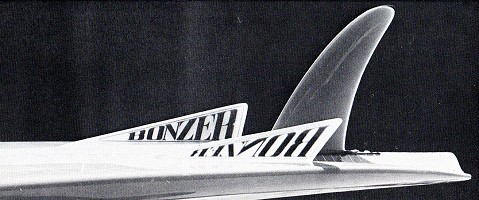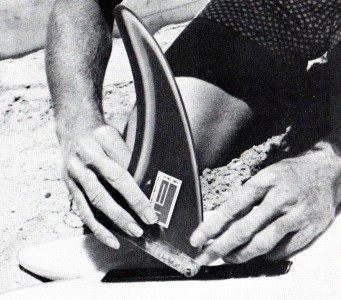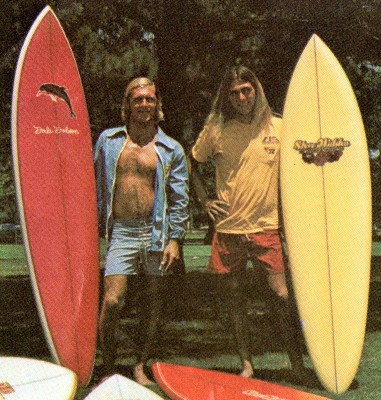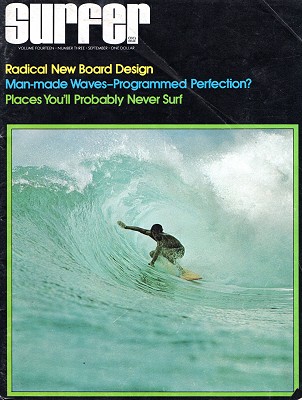 |
surfresearch.com.au
campbell bros. -
bing : bonzer, 1973
|
Jim Neece : Duncan and Malcom Cambell's Bonzer, 1973.
Jim Neece : The Bonzer.
Surfer
Volume 14 Number 3 September 1973.
Introduction
zer
Original design 1973 by Campbell brothers (USA) characterised by forward concave leading to double concave each side of the centre fin with two keel- type fins set on the rails (radically toed-in and cambered).
Bottom design based on the shape of Rigalto hang gliders.
Bonzer :Australian expression for excellent, occasionally spelt Bonza.
The design quickly spread across the Pacific and to several Australian exponents including Peter Townend (Gordon and Smith Surfboards) and Terry Richardson (Skipp Surfboards).
Preceeded by the Tri-fin 1971,
Influence on the Thruster 1981,
Adaptation 1988, the Phazer.
zer
Original design 1973 by Campbell brothers (USA) characterised by forward concave leading to double concave each side of the centre fin with two keel- type fins set on the rails (radically toed-in and cambered).
Bottom design based on the shape of Rigalto hang gliders.
Bonzer :Australian expression for excellent, occasionally spelt Bonza.
The design quickly spread across the Pacific and to several Australian exponents including Peter Townend (Gordon and Smith Surfboards) and Terry Richardson (Skipp Surfboards).
Preceeded by the Tri-fin 1971,
Influence on the Thruster 1981,
Adaptation 1988, the Phazer.
Page
63
They started out with two side fins
mounted just ahead of the center fin, thinking it might
increase speed, and sure enough it did.
Then they started tuning the fin shapes and positions, and over the course of a year or so, worked them into the present size and attitude.
Everytime they went through a series of changes, they found improvement.
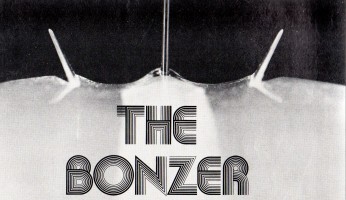
By Two Surfers in Search of Speed
|
Garish? A bit, perhaps. Functional? The possibilities are intriguing. The word "Bonzer" is Aussie slang which translates into something like bitchen, fantastic or superior. That's the tag that Malcolm and Duncan Campbell, two surfers from Oxnard, California, put on their new idea a couple of years ago. Their dad is an avid sailor and very much into hull design. His main interest was speed, and he encouraged his sons to come up with something different on their boards. Something to allow them to go a little faster, to work better in general. |
Then they started tuning the fin shapes and positions, and over the course of a year or so, worked them into the present size and attitude.
Everytime they went through a series of changes, they found improvement.
MALCOLM: "We got the fin positions down just about to where we have them now, canted in towards the nose of the board about seven degrees before we had any concave, so then we began looking for a way to create even more speed.
And so we were looking through some books that my dad has on hydrodynamics.
We were looking for a way to channel the water."
DUNCAN: "And detour the water away from turbulence."
MALCOLM: "To keep the turbulence away from the fins.
So, as a result of our research, we decided to add a double concave area in the tail to help channel the water off and increase the total effect.
Most of the turbulence occurred behind the trailing edge of the fin.
And so what we did with our fins and channels was to detour the water away from that area behind the center fin while altering the shape of the center fin (straighter trailing edge) to further reduce drag."
DUNCAN: "It forms a venturi."
MALCOLM: "The concaves added a lot of speed, and they made the riding characteristics much smoother."
MIKE EATON: "An idea that occurred to me was that they're channeling the water through the fin area, right?
So if you can start channeling the water right away, the effect is just amplified."
BING: "Like if the water escapes off the side of the board, you're not making use of that water at all.
If you can make it
"You've never seen a gimmick go so fast." - Jim Neese
Page 64
(If you can make it) go all the way down the bottom and out the tail, you really reduce the drag."
EATON: "Like when you're planing on the water, you're pushing water out from under the board in all different directions, so if you put a channel or a concave through the bottom of the board, this gives the water another direction to escape to; instead of escaping off the side of the board, it would tend to run down this channel, so when it gets into this channel, the surrounding water tends to throw it out the back, instead of just escaping out the side and dissipating itself.
So if you can get it flowing out the back end of the board, it's actually pushing you.
And you can feel it. Listen, when they first brought this in, my reaction was, oh wow, here we go again, and I didn't make one for myself for a while.
But the minute I got on it, you could feel the difference.
They paddle easy, and they get into a wave real easy, and the minute they get into a wave, you can feel it.
They just go whoossh.
It's like a similar thing with those planing boats that have strakes on their bottom, you know.
The water that normally just goes up into the bow wake, what they've done with those boats is to put those strakes in there so that the water that's going out in a big sheet is deflected back and under, and is actually giving them lift."
MALCOLM: "That's something right there.
Okay, now you've got your speed, for straight out speed, that's something we've already discussed, but when you drop in and you're going for a bottom turn, you've constantly got a vertical fin in the water (Malcolm pointing to one of the canted runners, points out that when the board is on edge, the fin actually has a more or less vertical attitude to the face of the wave).
That fin gives you added control through a turn, so there's your control.
Then you've got water coming across the bottom of the board.
Now on a single fin, all that water that's traveling across the board is just escaping off the outer edge.
That water's wasted, but on the Bonzer, the water comes across, strikes the outside runner, and is deflected down and back through the channel, and that water that's deflected back gives you an increase in acceleration.
And with your inside runner canted towards the nose, it automatically has a tendency to turn your board in towards the face of the wave, or to pinch it in and up.
So it has a tendency to pull your turn even tighter; and added to that is the force of the water against your outside runner which allows you to put more pressure on your inside edge."
EATON: "Of course, if those fins aren't put on right, you'll just track out in a straight line."
MALCOLM: "That's right, that's what happens.
"Bernuli's Principle: the lateral pressure is inversely proportional to the square of the velocity," or in lay terms, "the faster a fluid flows through a restricted area, the lesser the pressure."
A venturi: works like the nozzle of a garden hose.
DUNCAN: "Actually the water is leaving the board at a higher speed than it encountered the board at."
MALCOLM: "That's right.
You see, the faster a board's going, the looser it is.
Like you can be running on slow water, but you have faster water moving between your fins.
And, of course, the runners help; in fact, I think they're really the main factor."
The Bonzer boys say that you would ride a plan-shaped board similar to what you might be liking now.
MALCOLM: "It still just really depends on what kind of shape you prefer.
You wouldn't change the outline shape in consideration to this bottom except that you might not have as narrow a tail.
The wider the tail, the more planing area you have, and thus the faster.
Like a kneeboard with a 15-nch tail goes extremely fast."
EATON: "It seems that they're so positive that you can ride a wider tail.
The only reason you ride a narrow tail is that you need the control on a big wave.
You pull the tail in to keep the fin in the water, but on these boards they're real positive anyway, so you can widen them up, and you can get more punch out of them because you have more planing area right under the area in which you're punching your turn."
As far as performance is concerned, those that have had a chance to ride a Bonzer have been stoked.
Mike Eaton took one to Hawaii this summer and tells the following story:
EATON: "Well, I went over there on May 2, and there wasn't a whole lot of surf.
I took a little Bonzer over with me- it was 6'6" and about 20" wide.
I figured we'd get some maybe three- or four-foot surf and try it out, but Sunset came up one day, I mean nothing else had broken, but Sunset came up on this afternoon, and I paddled out, and the whole time I was paddling out I was looking at this board I was on thinking, what am I doing?
And I got out there, not really expecting it to work, and I took off on a wave, and it ran down the face- it was hard to get into waves because the board was so small - but it went down the face with real nice control, real positive, and it had a lot of speed; you could really feel it over there.
| It was really
apparent; you could really feel the difference. I rode a couple of waves, went over the falls on one because I had trouble getting into them, but I was really stoked, so I went up to Jeff's (Hakman) house and pumped him, because he was pretty skeptical. Anyway, I got him on the board the next day and let him paddle out before I hit the water. I had his board, and he got all the way out before I hit the water. I didn't want to give him a chance to renege (chuckle). And it was good eight-foot, clean, spring Sunset. That's an Island eight foot, of course. And he took off on one wave, and mind you I had his board, his 7'4", so he could get it back if he wanted. And he took off on this one wave, and when he paddled back out, I said, hey, what do you think? And he just looked at me, and really didn't say much of anything. And he took off on another wave, and this just kept going on and on. He didn't really know what to say, but he was really going fast. I mean I was out in the back, and so I really couldn't see except that he was getting in the waves late because the board was really so small. And pretty soon, guys were paddling out, going, 'what is that thing?' It's like Bruce Webb came out and said, I can see why Jeff really likes that African board.' Jeff had a board similar size and clear that he had made in Africa that he had really liked. And I said no that's a Bonzer. And other guys came out and said |
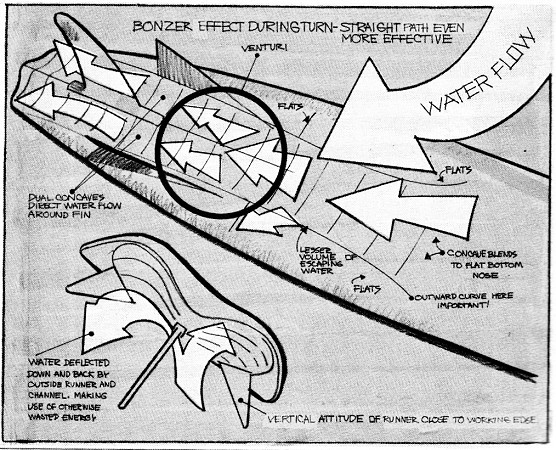 |
Jeff was going really fast.
Anyway, we were out for two-and-a-half hours and he never asked for his board back.
And finally I went in with his board; he was still out there, and I watched from the beach for a while.
He was getting in late, really hitting turns hard, like he does, on this real wide 14" tail, 6'6" board, and just hitting his turns really hard and getting a lot of drive out of the turns, and right up into the lip with the wave going over him and going extremely fast.
It was amazing on such a little board.
Anyway, he finally came in, and he was pretty impressed with the speed.
Now that particular board is pretty parallel.
It doesn't really suit his style of surfing, arcy, you know, it's more of a trimmer.
You know a lot of the same things that influence regular boards work the same on these.
But they're really good for nose riding, which is what that one was made for.
You could actually turn it up on the nose.
Anyway, Jeff wanted one after that."
Even though Malcolm and Duncan's Bonzer theory seems practical on paper, they have encountered the usual skeptical response from many surfers who just can't accept that a board that weird looking can work better.
MALCOLM "We've been messing around with this for three years, and people up by where we live have been looking at them and saying, well that's a joke.
But as soon as word got out that Bing was even considering producing them, everybody went, wow!
That must be a good idea.
Everyone's first reaction is usually, well, it sure looks like a lot of drag; the more you put back there, the more drag you're gonna get.
They've been seeing them work everyday, and they still were thinking there's no way they can work.
We were afraid that the percentage of favorable responses wouldn't be that good, because up where we live, people that hadn't tried them were so down on them that we got kind of a complex about the thing."
DUNCAN: "How many have we sold?
Twenty-five, thirty, just
There isn't one person that ever wants to ride a single fin again."
The general qualities of the Bonzer are speed, looseness and positive control.
And although the combination of those qualities seems contradictory, feedback from those riding them now tends to support the claim.
BING: "We sent a Bonzer back to Claudie, and his wife was having a baby at the time, and so he couldn't get right on the board, so he gave it to Dickie Munson, and Dickie took it up to Hatteras, and just called me and said that the board worked well."
EATON: "And he called without being propagandized or anyone talking to him or telling him about the qualities of the board, or anything.
It was just a cold shot.
He got the board, didn't know much about it, took it up, rode it, and was stoked enough to call us."
BING: "The one thing that I've noticed most in the comments that I've gotten from the guys who have tried them have been cutbacks.
Everyone says, wow, they cut back, they cut back."
DUNCAN: "It sounds far out, but you actually gain speed out of your cutbacks.
You can be drifting out into the flat and hit your cutback, and you'll actually gain speed, because you're racing the water faster through the tail section and it actually gives you acceleration."
MALCOLM: "The main thing has been that anyone that's ridden a Bonzer for any length of time has not wanted to go back to a single fin."
But again, as in all new surfboard ideas, the proof of the Bonzer's true functional value will come from a wide range of surfers trying them over a period of time in varying conditions.
One thing's for sure, the Bonzer is definitely worth looking into.
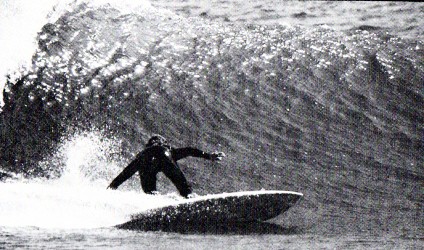 |
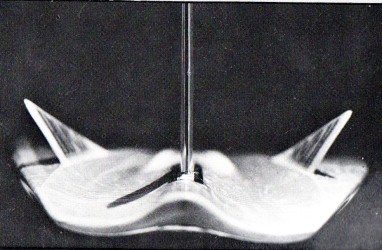 |
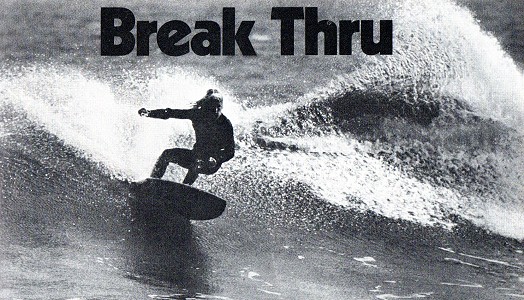 |
The BONZER breaks
thru into a new dimension of speed and high
performance, based on the proven physics of the
Venturi principle. The venturi bottom contour of the BONZER shape draws energy from the water flow off your board, decreasing drag while increasing acceleration and forward thrust. The BONZER is remarkably loose, yet positive; it squirts out of cutbacks. No spin-outs even in the steepest situations. After three years of basic testing and refinement, and after three months of fine-tuning both in the shaping room and in the water, the BONZER is ready. Malcolm Campbell carves a Bonzer track. |
Finely crafted by Bing.
 |
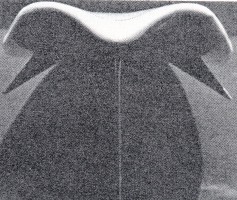 |
